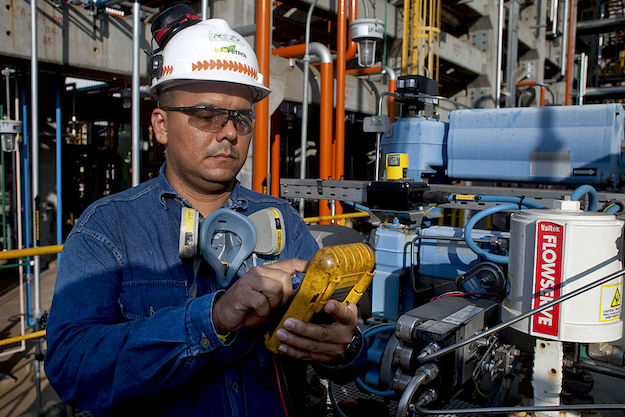Until recently, U.S. policymakers grappled with allowing natural gas to be freely exported. After studying the consequence for the domestic industry, federal regulators determined exports were in the public interest, and gave companies free rein to ship gas overseas. The U.S. is now poised to be one of the world’s largest exporters of liquefied natural gas (LNG).
This left countries on the receiving end of that energy bounty in a position of having to sort through what all this gas means for them.
One of those debates is unfolding in Colombia, where it will be a key economic issue awaiting the winner in this year’s presidential race. Natural gas is a growing part of the country’s energy mix, and now makes up more than one-fifth of its total energy basket. But its main fields are depleting and new discoveries have not kept pace with consumption. Barring any major finds, the government’s energy planning commission forecasts that in five years the country will run a supply deficit.
Their proposed solution: a new LNG facility to import gas.
Colombia already has one terminal to receive and re-gasify LNG on its Caribbean coast near Cartagena. The government is proposing a second one along the country’s Pacific shores, close to the seaport city of Buenaventura. Unlike the Cartagena facility, which mainly functions as a fail-safe for low hydropower supplies during El Niño seasons, a Pacific terminal would supply gas for all sectors – residential, power, and industrial.
In one sense, the government’s proposal is a convenient market-oriented solution: A country running short on gas taps global markets that are amply supplied with LNG. U.S. gas production and exports have indeed transformed the global gas trade in recent years. But Colombia-bound LNG could also come from neighboring gas exporters Peru or Trinidad and Tobago.
A sticking point, however, is that Colombia does have its own gas, and potentially lots of it. Five years ago, as the U.S. shale revolution was hitting full stride, a study by the U.S. Energy Information Administration assessed Colombia as having 55 trillion cubic feet of technically recoverable shale gas. The figure is modest compared to the U.S. or Argentina, but sufficient to draw interest from international oil companies with deep knowledge and experience developing shale resources.
In the offshore terrain, state oil firm Ecopetrol and U.S. operator Anadarko last year reported Colombia’s largest gas find in nearly three decades in the ultra-deep waters of the Caribbean Sea. Their discovery has fanned optimism of a future deep-water gas industry. International heavyweights Royal Dutch Shell, Petrobras and Spain’s Repsol are also investing in deep-water blocks.
With so much gas waiting to be discovered, local producers ask, why is the government floating plans to import gas to the tune of $400 to $600 million? The price tag includes the cost of the LNG facility and of a pipeline more than 60 miles long that would cross mountains and valleys to connect to the main transmission grid.
With this planning, federal authorities are taking prudent measures to cover a looming energy deficit. But in the longer term, more can be done to stimulate domestic exploration and production to maintain self-sufficiency, argue experts in Colombia’s oil and gas industry. Unlike larger countries like Brazil or Mexico, where both imports and domestic production are needed to balance demand, a few large deep-water projects would likely be enough to cover the gas needs of a market Colombia’s size.
The hurdles to developing such a deep-water industry are high, though not insurmountable. Entirely new regulations are needed, distinct from those that apply to the shallow water exploration that has historically sourced much of Colombia’s gas. Large infrastructure investments would also be required to transport deepwater discoveries to shore. Once on shore, gas would have to travel long distances to Bogotá, Medellín or Cali, major cities with significant demand. Transmission tariffs would also have to be revised to make that transport economically viable, producers argue.
Taken together, domestically-produced deep-water gas will be costly, likely more expensive than LNG. But the trade-offs would include potential jobs, sectoral know-how, resource royalties, tax revenues, and the associated benefits that come with building a domestic industry.
Companies producing on-shore gas, meanwhile, can undercut LNG prices with their lower-cost operations. The challenge for them is garnering public acceptance of their projects. Horizontal drilling, hydraulic fracturing, and other techniques to exploit shale gas are also new territory for Colombia, where environmental sensitivities run deep and skepticism towards resource projects is often fierce.
The federal government has given mixed signals regarding its support for domestic production of shale oil and gas. The Energy Ministry has issued regulations for shale operations, but the Ministry of Environment has yet to publish its equivalent terms of reference, which would provide a roadmap to investors. The result is what industry insiders describes as a state of paralysis for shale projects: companies bid on blocks at the government’s behest, but a prolonged and subjective environmental approval process threatens to shelve their investments. Projects that get underway can be shut down by plebiscites known as popular consultations if local communities vote against them.
Marshalling broad public acceptance to develop shale and other unconventional resources would require expending political capital that few in the Colombian industry think the government is in a position to do. The norms and legislation to advance shale projects need to address deeply systemic and socially contentious issues related to environmental conservation, equitable public resource distribution, and the balance of legal powers between federal and local levels. Given all this, it seems much easier to import gas from abroad.
Despite the challenge, Ecopetrol is prioritizing natural gas, and planning pilot projects that test-run shale developments. The government intends to use those results as a bellwether for shale’s viability in Colombia, buying it a few more years in the unconventional resource debate. The wait will be less beneficial, however, for international companies operating in Colombia, which are much further along than Ecopetrol in their planning and readiness to develop shale. Competition for foreign investment is fierce and industry capital tends to flow where the political uncertainties and risks are the lowest.
The issue of what to do about natural gas will be a high priority on the energy agenda of Colombia’s next president, who will need to weigh the benefits of imports vis-à-vis policies that stimulate greater domestic production. Both come with high costs, politically, economically and socially. But more than short-term costs, what he or she should consider is what option represents the best long-term investment in Colombia’s economy, and generates the highest return for the country’s industries and competitiveness.
—
Mendoza is director of the energy program at AS/COA







